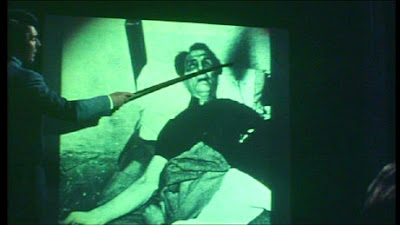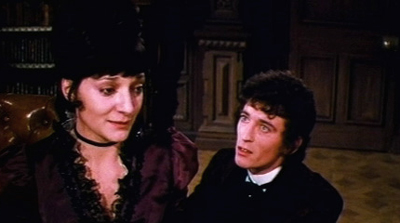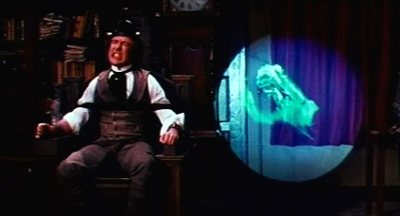
 |
|
|
|
One of DVD Savant's first reviews in 1999 was for a disc from a pioneering label that seemed to specialize in movies I wanted to see. At a time when the DVD shelves had fewer than a few hundred releases, there next to the initial Warner and MGM discs were titles like The Sadist and Ganja & Hess. All Day Video's David Kalat found a letterboxed source for The Asphyx, a horror film. We didn't care that the transfer had issues -- we were grateful just to finally have access to a movie with a powerful reputation. Thirteen years later, Kino-Lorber's new tie-in with the English Redemption label is conjuring high-quality Blu-rays of some of the more exotic horror fare from England and Europe. The Asphyx is back, now in a definitive restored presentation. 
The Asphyx is a rare English horror effort from the early '70s that takes a decidedly original approach to its scares. After Hammer Films had failed to bolster the faltering market for monster mayhem by turning to nudity and belatedly swinging London foolishness, out came this attraction starring prestigious actors and lensed in a beautiful widescreen process by one of the best British cameraman of the sixties. The Asphyx is far from a perfect film, but it aces one aspect of its mission: moments in the picture truly horrify, giving one sickly tingles up the spine. The characters engage in civil conversations in drawing rooms ... but the show builds a disturbingly morbid mood. The story takes place in 1875, in an English family of wealthy intellectuals. Scientist and philanthropist Sir Hugo Cunningham (Robert Stephens) has been photographing dying men. He boasts to his 'psychic society' that the dark blurs recorded on his negatives are images of the human soul leaving the body at death ... physical proof of the existence of the spirit world. Sir Hugo happens to be shooting motion pictures of his son and his own fianceé just as an accident takes their lives. His movies record the blur as well, which moves toward the victims, not away from them. This prompts Sir Hugo to alter his theory: the phenomenon recorded is not the soul, but a mythological spirit that appears only at the moment of death to claim the living: The Asphyx. An experiment at a public hanging allows an Asphyx to be seen more clearly. A bright blue spotlight beam created by water dripping on special crystals paralyzes the hanged man's Asphyx and prevents it from reaching him. The dangling body shakes horribly until Sir Hugo shuts down his apparatus a few seconds later. Only then is the Asphyx free to perform its function, and the man dies. Sir Hugo embarks on a morbid quest. He reasons that any person will be virtually immortal if his Asphyx can be trapped in the light of the blue crystals. Driven by misplaced grief over the loss of his loved ones, he successfully 'immortalizes' a Guinea Pig. When an attempt to do the same with a dying, consumptive pauper fails, Sir Hugo makes a bargain with his colleague (and adopted son) Giles (Robert Powell): if Giles helps to immortalize him, Sir Hugo will do the same in turn with Giles and his fianceé Christina (Jane Lapotaire). The Cunninghams will live forever and become masters of the world. There's only one catch: the Asphyx materializes only when a person is at the brink of death. Sir Hugo sets to building horrible electric chairs and guillotines in his basement laboratory ... The Asphyx is genuinely chilling. A sense of dread hangs over the entire story. The Cunninghams are a proper, progressive Victorian family, and Sir Hugo is exactly the kind of elite optimist whose good intentions pave that proverbial road to Hell. Robert Stephens, so good as Billy Wilder's detective hero in The Private Life of Sherlock Holmes, captures both the exuberance and mania of an upper-class scientist who dares usurp the power of life and death. If Gothic Horror is 'about' families, as scholars claim, then The Asphyx is about Sir Hugo's abuse of his patriarchal authority, bullying his offspring into subscribing to his obsession. Stage actors Robert Powell and Jane Lapotaire perform with compelling sincerity. We care about these privileged characters and must watch as they destroy themselves in a misguided quest for immortality. 
Restrained direction by Peter Newbrook (mostly wide masters) and immaculate Todd-AO 35 cinematography by Freddie Young create a pictorially sumptuous Victorian atmosphere, as does Bill McGuffie's beautiful romantic music score. The modest production appears to use some familiar Hammer locations. The tragedy at a boating picnic is reminiscent of Ken Russell's Women in Love. A convincingly brutal hanging is attended by a mixed mob of bloodthirsty sightseers and anti-death penalty protesters. Sir Hugo's lab displays the paraphernalia of death: coffins, cages and technological torture devices. As many viewers have since pointed out, the method of catching and imprisoning The Asphyx is almost identical to the 'proton packs' and 'laser containment grids' used to snag phantoms twelve years later in the horror comedy Ghostbusters. When we finally see the glowing green critter, it looks very much like one of the phantoms in Ivan Reitman's film. But the screams and howls of the imprisoned Asphyx are too unpleasant to be funny, especially when we're transfixed by the near-death experiences of Sir Hugo's latest test subject. The scenes with Christina will make any married man uncomfortable. Giles coaxes and goads her into resting her neck under the blade of a guillotine, assuring her that nothing can possibly go wrong ... and that immortality will be her reward. For once, an original screen idea (by Christina and Laurence Beers) is worthy of Edgar Allan Poe. Just when we think things can't get worse ... they do. The macabre idea behind The Asphyx resonates with older tales of terror. Since Victorian times, modern technology has been criticized as threatening the spiritual health of man. We've long been told that some primitive cultures believe that photographs 'trap the soul' in the same way Sir Hugo's photo light traps mythological specters. The specific idea that a person could be prevented from dying even if mangled beyond repair brings back memories of the chilling W.W. Jacobs story The Monkey's Paw: keeping an executed person alive simply extends their suffering. It may also remind horror fans of an undeveloped idea in Tod Browning's freakish The Devil-Doll, where a hypnotized homunculus suffers in silence. And the investigation of a formerly unknown "thing" with a role to play in human suffering also has elements in common with William Castle's The Tingler. Director Peter Newbrook keeps our emotions engaged but cannot disguise his film's gaping lapses of logic. Sir Hugo has invented a movie camera twenty years too early, a strange anachronism. When this cinematic genius screens his hand-cranked, single-camera production, a close-up is automatically edited into the reel -- in anticipation of an accident that Sir Hugo didn't see coming. Later, when the 'immortal' Sir Hugo spends a night sealed in an airtight casket, why isn't he gasping for air in excruciating torment? Why don't his brain cells expire, leaving him an immortal vegetable? Many physical details hamper our full appreciation of the film's clever plotting. Why do Sir Hugo and Giles contrive such clumsy, erratic 'near death' devices, putting the lives of their precious loved ones at risk without so much as a practice run to eliminate basic errors? What are these incredible blue crystals that provide limitless perpetual phosphorescence? How 'eternal' can the Asphyx vault be, should the local water spring dry up or the plumbing give out? Especially when everything that could go wrong with all of Sir Hugo's previous inventions, has? 
Luckily, our fascination with the grisly goings-on outweighs these confusing non-sequiturs that, it must be admitted, manage to fully express the way that the plans of good men go awry. Audiences may be underwhelmed by the ghostly puppet form taken by the dreaded Asphyx, but they're not likely to forget it either. The Asphyx succeeds in its basic mission to deliver a startling tale of terror. Kino-Lorber & Redemption's Blu-ray of The Asphyx is a flawless HD transfer of this unique shocker, sourced directly from the original 35mm negative. After a brief opening in the present day, the main titles take us back to 1875 and a painstakingly beautiful image of Sir Hugo's ruined lab. The vibrant audio track contrasts the beauty of Bill McGuffie's music with the terrible screaming of the title phantom. The basic movie encoded on the disc is the shorter U.K. release version (86 minutes). The extended American cut, which is twelve minutes longer, is accessed through the extras menus. Viewers should be aware that the original negative was conformed to the U.K. version. The extended U.S. scenes are from a surviving print, resulting in a severe drop in quality whenever censored material appears. All of the cut material extends dialogue scenes. They may not advance the story but they certainly clarify the characters -- in the very first deleted scene, Sir Hugo announces his upcoming wedding. An original trailer and a brief image gallery are also present. No commentary or text extras are offered to explain how The Asphyx came about. Director Peter Newbrook was a camera operator under the famed Freddie Young when he undertook a number of small productions in the early 1970s. For this show Young served as Newbrook's Director of Photography. Although produced on a limited budget, the expert visuals work up plenty of atmosphere. The old reference books are correct: a logo in the main titles declares that the film originally premiered in "Super Quadraphonic Sound". The presentation here is monaural.
On a scale of Excellent, Good, Fair, and Poor,
The Asphyx Blu-ray rates:
Reviews on the Savant main site have additional credits information and are often updated and annotated with reader input and graphics. Also, don't forget the 2011 Savant Wish List. T'was Ever Thus.
Review Staff | About DVD Talk | Newsletter Subscribe | Join DVD Talk Forum |
| ||||||||||||||||||